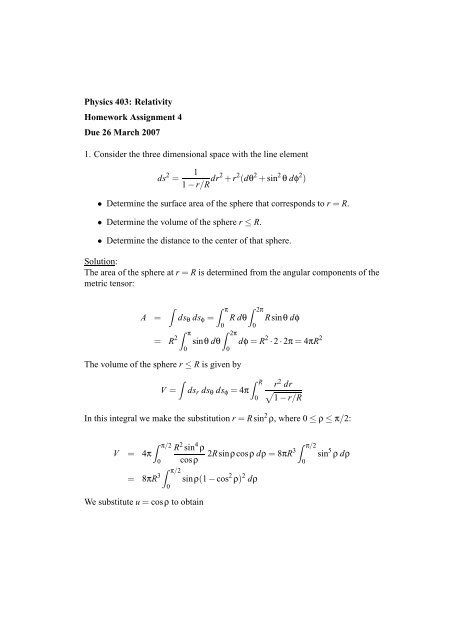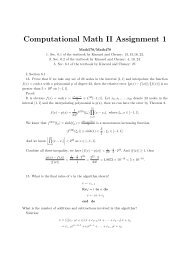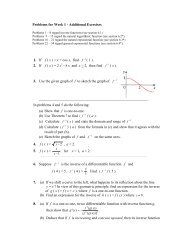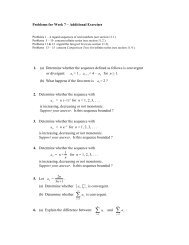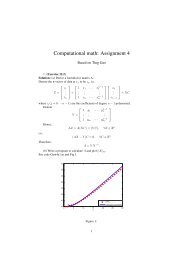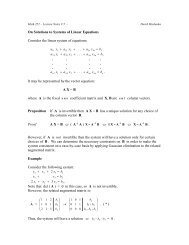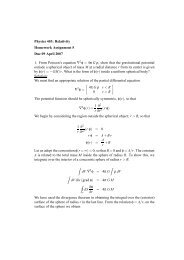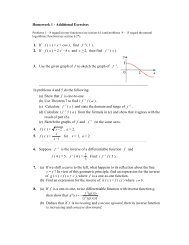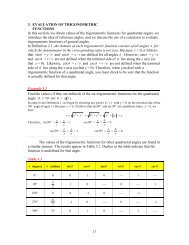Physics 403: Relativity Homework Assignment 4 Due 26 March ...
Physics 403: Relativity Homework Assignment 4 Due 26 March ...
Physics 403: Relativity Homework Assignment 4 Due 26 March ...
You also want an ePaper? Increase the reach of your titles
YUMPU automatically turns print PDFs into web optimized ePapers that Google loves.
<strong>Physics</strong> <strong>403</strong>: <strong>Relativity</strong><br />
<strong>Homework</strong> <strong>Assignment</strong> 4<br />
<strong>Due</strong> <strong>26</strong> <strong>March</strong> 2007<br />
1. Consider the three dimensional space with the line element<br />
ds 2 =<br />
1<br />
1 − r/R dr2 + r 2 (dθ 2 + sin 2 θ dφ 2 )<br />
• Determine the surface area of the sphere that corresponds to r = R.<br />
• Determine the volume of the sphere r ≤ R.<br />
• Determine the distance to the center of that sphere.<br />
Solution:<br />
The area of the sphere at r = R is determined from the angular components of the<br />
metric tensor:<br />
A =<br />
Z<br />
ds θ ds φ =<br />
Z π<br />
= R 2 sinθ dθ<br />
0<br />
Z π<br />
0<br />
Z 2π<br />
The volume of the sphere r ≤ R is given by<br />
Z<br />
V =<br />
0<br />
Z 2π<br />
R dθ<br />
0<br />
Rsinθ dφ<br />
dφ = R 2 · 2 · 2π = 4πR 2<br />
Z R r 2 dr<br />
ds r ds θ ds φ = 4π √<br />
0 1 − r/R<br />
In this integral we make the substitution r = Rsin 2 ρ, where 0 ≤ ρ ≤ π/2:<br />
V<br />
Z π/2 R 2 sin 4 Z<br />
ρ<br />
π/2<br />
= 4π<br />
0 cosρ 2Rsinρcosρ dρ = 8πR3 sin 5 ρ dρ<br />
0<br />
Z π/2<br />
= 8πR 3 sinρ(1 − cos 2 ρ) 2 dρ<br />
We substitute u = cosρ to obtain<br />
0
Z 1<br />
V = 8πR 3 du (1 − u 2 ) 2 = 8πR 3 8<br />
15 = 64π<br />
15 R3<br />
0<br />
This volume is somewhat larger than the volume of a sphere in Euclidean space,<br />
4πR 3 /3.<br />
The distance to the center of the sphere is again calculated from the metric tensor:<br />
Z<br />
D 0R = ds r =<br />
Z R<br />
0<br />
Z √<br />
dr<br />
R R dr<br />
[<br />
√ = √ = −2 √ ] r=R<br />
R(R − r) = 2R<br />
1 − r/R 0 R − r r=0<br />
Again, the distance s 0R is greater than the Euclidean distance, R.<br />
2. The two dimensional torus can be embedded into three dimensional Euclidean<br />
space by the relations<br />
x<br />
y<br />
z<br />
= Rcosθ [1+ρsinφ]<br />
= Rsinθ [1+ρsinφ]<br />
= Rρcosφ<br />
where 0 < ρ < 1 is a fixed parameter. Compute the following quantities for the<br />
torus, parametrized by (θ,φ):<br />
• The metric tensor induced by the embedding from the Euclidean metric.<br />
• The Christoffel symbols<br />
• The Riemann curvature tensor.<br />
• The Ricci scalar<br />
Solution:<br />
The infinitesimal Cartesian displacements (dx,dy,dz) are calculated in terms of<br />
(dθ,dφ) as<br />
dx<br />
dy<br />
dz<br />
= −Rsinθ (1+ρsinφ) dθ+Rρcosθcosφ dφ<br />
= Rcosθ (1+ρsinφ) dθ+Rρsinθcosφ dφ<br />
= −Rρsinφ dφ
Thus we calculate the infinitesimal distance ds 2 :<br />
ds 2 = dx 2 + dy 2 + dz 2 = R 2 (1+ρsinφ) 2 dθ 2 + R 2 ρ 2 dφ 2<br />
The nonvanishing components of the metric tensor are g θθ = R 2 (1+ρsinφ) 2 and<br />
g φφ = R 2 ρ 2 .<br />
The Christoffel symbols are given by the formula<br />
Γ λ µν = 1 2 gλρ [ ∂ ν g ρµ + ∂ µ g ρν − ∂ ρ g µν<br />
]<br />
The following Christoffel symbols are non-vanishing:<br />
Γ φ cosφ (1+ρsinφ)<br />
θθ<br />
= −<br />
ρ<br />
Γ θ φθ = ρcosφ<br />
Γθ θφ =<br />
1+ρsinφ<br />
The Riemann curvature tensor is<br />
R α βγδ = ∂ γ Γ α βδ − ∂ δ Γ α βγ + Γα γε Γε βδ − Γα δε Γε βγ<br />
The nonvanishing components of the Riemann tensor are<br />
R φ θθφ<br />
= −R φ θφθ = sinφ<br />
ρ<br />
(1+ρcosφ)<br />
R θ φθφ = −R θ φφθ = ρsinφ<br />
1+ρsinφ<br />
The Ricci tensor is R µν = R λ µλν<br />
. Its nonvanishing components are<br />
The Ricci scalar curvature is<br />
R θθ = sinφ<br />
ρ<br />
(1+ρsinφ)<br />
ρsinφ<br />
R φφ =<br />
1+ρsinφ
R = g µν R µν = 2 sinφ<br />
R 2 ρ 1+ρsinφ<br />
We may compute the Killing vectors k µ = [k θ (θ,φ), k φ (θ,φ)] for this geometry by<br />
solving the equations<br />
That is,<br />
∂ µ k ν + ∂ ν k µ − 2Γ λ µν k λ = 0<br />
∂ θ k θ = Γ φ θθ k φ = − cosφ(1+ρsinφ)<br />
ρ<br />
∂ θ k φ + ∂ φ k θ = 2 Γ θ θφ k ρcosφ<br />
θ = 2<br />
1+ρsinφ k θ<br />
∂ φ k φ = 0<br />
From the last relation we conclude that k φ is independent of the variable φ. The<br />
second relation can be written as<br />
k φ<br />
∂ φ k θ − 2<br />
ρcosφ<br />
1+ρsinφ k θ<br />
[ ]<br />
(1+ρsinφ) 2 k θ<br />
∂ φ<br />
(1+ρsinφ) 2<br />
= −∂ θ k φ<br />
= −∂ θ k φ<br />
We define the quantity g(θ) = −∂ θ k φ , and write this equation as<br />
( )<br />
k θ<br />
g(θ)<br />
∂ φ<br />
(1+ρsinφ) 2 =<br />
(1+ρsinφ) 2<br />
Let us integrate with respect to the variable φ to obtain<br />
[<br />
Z φ<br />
k θ = (1+ρsinφ) 2 dφ ′ ]<br />
f(θ)+g(θ)<br />
π/2 (1+ρsinφ ′ ) 2<br />
We insert this relation into the first Killing vector relation, to obtain<br />
[<br />
Z φ<br />
(1+ρsinφ) 2 f ′ (θ)+g ′ dφ ′ ]<br />
(θ)<br />
π/2 (1+ρsinφ ′ ) 2 = − cosφ(1+ρsinφ) k φ<br />
ρ
This equation must be satisfied at every value of the variable φ. Setting φ = π/2,<br />
we establish that f ′ (θ) = 0 at all θ. Consequently,<br />
Z φ<br />
g ′ (θ)<br />
π/2<br />
dφ ′<br />
(1+ρsinφ ′ ) 2 = − cosφ<br />
ρ(1+ρsinφ) k φ(θ)<br />
We differentiate both sides with respect to φ to obtain<br />
g ′ [<br />
]<br />
(θ)<br />
(1+ρsinφ) 2 = sinφ<br />
ρ(1+ρsinφ) + cosφ<br />
(1+ρsinφ) 2 k φ (θ)<br />
Since the relation must also be true at all φ, it follows that k φ (θ) = 0 and g ′ (θ) = 0.<br />
Furthermore, since g(θ) = −∂ θ k φ , it follows that g(θ) = 0. Consequently, f(θ) =<br />
f 0 is a constant, and the only Killing vector is<br />
k µ = f 0 [(1+ρsinθ) 2 ,0]<br />
Note that the corresponding contravariant Killing vector is<br />
k µ = g µλ k λ = f 0 [1,0]<br />
The existence of this Killing vector may be established from the fact that the<br />
metric tensor is independent of the coordinate θ. We have shown that it is the only<br />
Killing vector for this metric geometry.<br />
3. Show that for any two-dimensional manifold the covariant curvature tensor has<br />
the form<br />
R ab,cd = κ [g ac g bd − g ad g bc ]<br />
where κ may be a function of the coordinates. Why does this result not generalize<br />
to manifolds of higher dimensions?<br />
Solution:<br />
The covariant fourth order Riemann tensor has the following symmetry properties:<br />
R ab,cd = −R ba,cd = −R ab,dc<br />
In any two-dimensional space there can be only one independent component of<br />
that tensor, since the indices (a,b) as well as (c,d), must be distinct.<br />
Thus, of the 16 components of R ab,cd , we have
and all other components vanish.<br />
The tensor<br />
R 12,21 = −R 21,21 = −R 12,12 = R 21,12<br />
g ac g bd − g ab g cd<br />
has the same symmetry properties as R ab,cd , so that the two tensors must be proportional:<br />
R ab,cd = κ [g ac g bd − g ab g cd ]<br />
where κ may depend upon the two coordinates (u 1 ,u 2 ).<br />
For the example considered in Problem 2, we have<br />
R φθ,θφ<br />
= g φφ R φ θθφ = −R2 ρsinφ (1+ρsinφ)<br />
R θφ,θφ<br />
= g θθ R θ φθφ = R2 ρsinφ (1+ρsinφ)<br />
g θθ g φφ = R 4 ρ 2 (1+ρsinφ) 2<br />
The structure is evident in this case, with<br />
κ =<br />
Note that the scalar curvature is R = 2κ.<br />
sinφ<br />
ρR 2 (1+ρsinφ)<br />
4. Consider the Hyperbolic Plane defined by the metric<br />
ds 2 = dx2 + dy 2<br />
y 2<br />
where y ≥ 0. Show that the geodesics are semi-circles centered on the x-axis or<br />
vertical lines parallel to the y-axis. Determine x(s) and y(s) as functions of the<br />
length s along these curves.<br />
Solution:<br />
The line element ds 2 is invariant under a change in the scale of coordinates;<br />
(x,y) → (λ x,λ y). The components of the metric tensor are
g xx = 1/g xx = 1/y 2<br />
g yy = 1/g yy = 1/y 2<br />
g xy = g yx = 0<br />
The Christoffel symbols are determined by the formula<br />
Γ λ µν = 1 2 gλρ[ ]<br />
∂ ν g ρµ + ∂ µ g ρν − ∂ ρ g µν<br />
The non-vanishing Christoffel symbols are<br />
Γ x xy = Γ x yx<br />
= 1 2 gxx ∂ y g xx = − 1 y<br />
Γ y xx<br />
= − 1 2 gyy ∂ y g xx = 1 y<br />
Γ y yy<br />
= 1 2 gyy ∂ y g yy = − 1 y<br />
The Riemann tensor may be computed from the Christoffel symbols:<br />
R x yxy = −∂ y Γ x yx + Γx xy Γy yy − Γx yx Γx xy = − 1 y 2<br />
R xyxy = g xx R x yxy = − 1 y 4<br />
All other components of the Riemann tensor may be obtained using the formula<br />
in Problem 3, with κ = −1. Note that the scalar curvature is R = −2, and that it is<br />
scale-invariant.<br />
The equation for the geodesics u α (s) is<br />
That is,<br />
d 2 u α<br />
ds 2<br />
d 2 y<br />
ds 2 + 1 y<br />
+ Γα βγ<br />
du β<br />
ds<br />
du γ<br />
ds = 0<br />
d 2 x<br />
ds 2 − 2 dx dy<br />
= 0<br />
y ds ds<br />
( dx 2<br />
−<br />
ds) 1 ( ) dy 2<br />
= 0<br />
y ds
It follows from the definition of the metric<br />
that<br />
ds 2 = dx2 + dy 2<br />
y 2<br />
( ) dx 2 ( ) dy 2<br />
+ = y 2<br />
ds ds<br />
(This relation may also be obtained from the geodesic equations themselves.) We<br />
use this relation to case the geodesic equation for y(s) into the form<br />
( )<br />
y d2 y dy 2<br />
ds 2 + y2 = 2<br />
ds<br />
Adopting the notation y ′ = dy/ds, we may write<br />
d 2 y<br />
ds 2 = dy′<br />
ds = dy′<br />
dy<br />
Thus the geodesic equation for y takes the form<br />
dy dy′<br />
= y′<br />
ds dy<br />
y y ′ dy′<br />
dy + y2 = 2y ′2<br />
This is a nonlinear first order differential equation for y ′ as a function of y; y ′ (y).<br />
We express it in terms of t(y) = y ′2 :<br />
or<br />
y<br />
2<br />
dt<br />
dy + y2 = 2t<br />
dt<br />
dy − 4 y t = −2y<br />
We multiply this linear first order differential equation for t by the integrating<br />
factor 1/y 4 and solve it:
1 dt<br />
y 4 dy − 4 y 5 t = − 2 y<br />
( )<br />
3<br />
d t<br />
dy y 4 = d ( ) 1<br />
dy y 2<br />
t<br />
y 4 = −κ 2 + 1 y 2<br />
t = y 2 − κ 2 y 4<br />
Equivalently, we have<br />
y ′ = dy<br />
ds<br />
dy<br />
y 2√ 1/y 2 − κ 2<br />
= y √ 1 − κ 2 y 2<br />
= ds<br />
Let us define the variable u(s) = 1/y(s), so that du = −dy/y 2 and<br />
du<br />
√<br />
u 2 − κ 2 = −ds<br />
This equation may be integrated directly to obtain u = κcosh(s − s 0 ), or<br />
y(s) =<br />
1<br />
κcosh(s − s 0 )<br />
We may calculate x(s) using this result for y(s) the metric tensor relation:<br />
( ) dx 2 ( ) dy 2<br />
= y 2 − = y 2 − y 2 (1 − κ 2 y 2 ) = κ 2 y 4<br />
ds<br />
ds<br />
We take the positive square root to have<br />
Consequently,<br />
dx<br />
ds = κ = 1<br />
κcosh 2 (s − s 0 )<br />
x − x 0 = 1 κ tanh(s − s 0)
We also obtain<br />
(x − x 0 ) 2 + y 2 = 1+sinh2 (s − s 0 )<br />
κ 2 cosh 2 (s − s 0 ) = 1 κ 2<br />
The geodesic trajectory is thus a circle of radius R = 1/κ centered at the point<br />
(x 0 ,0), which lies on the x-axis. Actually, because y(s) is always positive, we<br />
should regard it as a semi-circle in the upper half y-plane. In the limiting case<br />
κ → 0, the geodesics become half-lines, x = x 0 ; y > 0.<br />
To summarize, the geodesic trajectory is parametrized by the formulas<br />
y(s) =<br />
R<br />
cosh(s − s 0 )<br />
x(s) = x 0 + R sinh(s − s 0)<br />
cosh(s − s 0 )<br />
Actually, we can solve for the trajectory y(x) more directly by determining the<br />
paths of minimum length<br />
Z Z √<br />
x2<br />
1+y ′ 2<br />
S = ds =<br />
dx<br />
x 1 y<br />
Because the “effective Lagrangian”<br />
L =<br />
√<br />
1+y ′ 2<br />
does not involve the dependent variable x, the “Jacobi integral” is a constant of<br />
the motion:<br />
y<br />
y ′ ∂L<br />
∂y ′ − L<br />
√<br />
y ′ 2 1+y ′<br />
y √ 1+y − 2<br />
′ 2 y<br />
1<br />
√<br />
y √ 1+y ′ 2<br />
= J = − 1 R<br />
= − 1 R<br />
= 1 R<br />
1+y ′2 = R y<br />
√<br />
y ′ R<br />
=<br />
2<br />
y 2 − 1
We integrate this equation to obtain<br />
Z y<br />
y dy<br />
√ =<br />
R 2 − y 2<br />
Z x<br />
dx = x − x0<br />
− √ R 2 − y 2 = x − x 0<br />
(x − x 0 ) 2 + y 2 = R 2<br />
To determine the arc length of a path, we use the original metric formula:<br />
ds<br />
dx<br />
=<br />
ds =<br />
√<br />
1+y ′ 2<br />
= R y y 2 = R<br />
R 2 −(x − x 0 ) 2<br />
Rdx<br />
R 2 −(x − x 0 ) 2<br />
We make the substitution x = x 0 + R sinθ to obtain<br />
ds = R secθ dθ<br />
s − s 0 = ln(secθ+tanθ)<br />
e s−s 0<br />
= secθ+tanθ<br />
sec 2 θ = tan 2 θ − 2 tanθ e s−s 0<br />
+ e 2(s−s 0)<br />
tanθ = sinh(s − s 0 )<br />
Note also that sinθ = tanh(s − s 0 ), so that<br />
x − x 0 = R tanh(s − s 0 )<br />
R<br />
y = R cosθ =<br />
cosh(s − s 0 )<br />
5. In a four-dimensional Minkowski space with coordinates (t,x,y,z), a 3-hyperboloid<br />
is defined by t 2 − x 2 − y 2 − z 2 = R 2 . Show that the metric on the 3-surface of the<br />
hyperboloid can be written in the form<br />
−ds 2 = R 2 [dχ 2 + sinh 2 χ (dθ 2 + sin 2 θ dφ 2 ) ]
Show that the total volume of the 3-hyperboloid is infinite.<br />
Solution:<br />
Let us define the coordinates (χ,θ,φ) in terms of (t,x,y,z) by<br />
t<br />
z<br />
y<br />
x<br />
= Rcoshχ<br />
= Rsinhχ cosθ<br />
= Rsinhχ sinθ sinφ<br />
= Rsinhχ sinθ cosφ<br />
With these coordinates, we automatically impose the constraint t 2 −x 2 −y 2 −z 2 =<br />
R 2 . The corresponding changes in these coordinates are<br />
dt<br />
dz<br />
dy<br />
dx<br />
= Rsinhχ dχ<br />
= Rcoshχcosθ dχ − Rsinhχsinθ dθ<br />
= Rcoshχsinθcosφ dχ+Rsinhχcosθsinφ dθ − Rsinhχsinθcosφ dφ<br />
= Rcoshχsinθcosφ dχ+Rsinhχcosθcosφ dθ − Rsinhχsinθsinφ dφ<br />
The Minkowski space metric may thus be written<br />
ds 2<br />
= dt 2 − dz 2 − dy 2 − dz 2 = −ds 2 χ − ds 2 θ − ds2 φ<br />
= −R 2 dχ 2 − R 2 sinh 2 χ dθ 2 − R 2 sinh 2 χsin 2 θ dφ 2<br />
The total three-volume of the hyperboloidal region χ ≤ χ 0 is<br />
Z<br />
Z χ0<br />
Z π<br />
Z 2π<br />
V = ds χ ds θ ds φ = R dχ Rsinhχ dθ Rsinhχsinθ dφ<br />
0 0<br />
0<br />
Z χ0<br />
Z χ0<br />
= 4πR 3 sinh 2 χ dχ = 2πR 3 (cosh2χ − 1) = πR 3 (sinh2χ 0 − 2χ 0 )<br />
0<br />
0<br />
The volume becomes infinite in the limit χ 0 → ∞.<br />
We could determine the geodesics for this surface by obtaining and solving the<br />
geodesic equations for (χ(s),θ(s),φ(s)). Instead, we will analyze the geodesic<br />
equations for (t(s),x(s),y(s),z(s)), using Lagrange multipliers to impose the constraint
The modified Lagrangian is<br />
[ ( ) dt 2<br />
L = −<br />
ds<br />
t(s) 2 − x(s) 2 − y(s) 2 − z(s) 2 = R 2<br />
( ) dx 2<br />
−<br />
ds<br />
The Euler-Lagrange equations are<br />
( ) dy 2<br />
−<br />
ds<br />
( ) ]<br />
dz<br />
2<br />
+ κ 2[ t 2 − x 2 − y 2 − z 2]<br />
ds<br />
d 2 t<br />
ds 2 − κ2 t = 0<br />
d 2 x<br />
ds 2 − κ2 x = 0<br />
d 2 y<br />
ds 2 − κ2 y = 0<br />
d 2 z<br />
ds 2 − κ2 z = 0<br />
The solution that passes through the first point on the hyperboloid, (t 1 ,x 1 ,y 1 ,z 1 )<br />
at s = 0, is<br />
t(s) = t 1 coshκs+d sinhκs<br />
x(s) = x 1 coshκs+asinhκs<br />
y(s) = y 1 coshκs+bsinhκs<br />
z(s) = z 1 coshκs+csinhκs<br />
We the curve satisfies the constraint<br />
t(s) 2 − x(s) 2 − y(s) 2 − z(s) 2 = R 2<br />
under the following conditions:<br />
t 2 1 − x2 1 − y2 1 − z2 1 = R 2<br />
t 1 d − x 1 a − y 1 b − z 1 c = 0<br />
a 2 − b 2 + c 2 − d 2 = R 2
The parameter κ can be determined from the constraint<br />
( ) dt 2<br />
−<br />
ds<br />
At s = 0 we obtain the relation<br />
( ) dx 2<br />
−<br />
ds<br />
( ) dy 2<br />
−<br />
ds<br />
κ 2 (d 2 − a 2 − b 2 − c 2 ) = −1<br />
( ) dz 2<br />
= −1<br />
ds<br />
or κR = 1. Under the conditions given above, this relation is satisfied everywhere<br />
on the curve.<br />
Next we determine S, the path length on the hyperboloid between the points<br />
(t 1 ,x 1 ,y 1 ,z 1 ) and (t 2 ,x 2 ,y 2 ,z 2 ):<br />
t 2 −t 1 coshρ<br />
x 2 − x 1 coshρ<br />
y 2 − y 1 coshρ<br />
z 2 − z 1 coshρ<br />
= d sinhρ<br />
= asinhρ<br />
= bsinhρ<br />
= csinhρ<br />
where ρ = κS = S/R. We square these terms and combine them to determine the<br />
parameter ρ:<br />
(t 2 −t 1 coshρ) 2 −(x 2 − x 1 coshρ) 2 −(y 2 − y 1 coshρ) 2 −(z 2 − z 1 coshρ) 2<br />
= (d sinhρ) 2 −(asinhρ) 2 −(bsinhρ) 2 −(csinhρ) 2 ;<br />
R 2 − 2(t 1 t 2 − x 1 x 2 − y 1 y 2 − z 1 z 2 )coshρ+R 2 cosh 2 ρ = −R 2 sinh 2 ρ ;<br />
(t 1 t 2 − x 1 x 2 − y 1 y 2 − z 1 z 2 )coshρ = R 2 cosh 2 ρ ;<br />
coshρ = (t 1 t 2 − x 1 x 2 − y 1 y 2 − z 1 z 2 )/R 2 .<br />
One may show that t 1 t 2 − x 1 x 2 − y 1 y 2 − z 1 z 2 ≥ R 2 , so that coshρ ≥ 1.<br />
t 1 t 2 − x 1 x 2 − y 1 y 2 − z 1 z 2 =<br />
≥<br />
√ √r1 2 + R2 r2 2 + R2 −⃗r 1 ·⃗r 2<br />
√ √r1 2 + R2 r2 2 + R2 − r 1 r 2<br />
Furthermore, we have
(r 1 − r 2 ) 2 ≥ 0 ;<br />
(r 2 1 + R 2 ) (r 2 2 + R 2 ) ≥ (r 1 r 2 + R 2 ) 2 ;<br />
√r 2 1 + R2 √<br />
r 2 2 + R2 ≥ r 1 r 2 + r 2 .<br />
The result is established. The coefficients (a,b,c,d) can then be determined:<br />
d<br />
a<br />
b<br />
c<br />
= (t 2 −t 1 coshρ)/sinhρ<br />
= (x 2 − x 1 coshρ)/sinhρ<br />
= (y 2 − y 1 coshρ)/sinhρ<br />
= (z 2 − z 1 coshρ)/sinhρ<br />
They automatically satisfy the relation a 2 + b 2 + c 2 − d 2 = R 2 . In addition, we<br />
may show by direct substitution that<br />
t 1 d − x 1 a − y 1 b − z 1 c = 1<br />
sinhρ [(t 1t 2 − x 1 x 2 − y 1 y 2 − z 1 z 2 ) − R 2 coshρ] = 0<br />
as required. The geodesic curve on the hyperboloid lies on a plane passing through<br />
the origin:<br />
α x(s)+β y(s)+γ z(s)+δ t(s) = 0<br />
The parameters (α,β,γ,δ) must satisfy the constraints<br />
α x 1 + β y 1 + γ z 1 + δ t 1 = 0<br />
α x 2 + β y 2 + γ z 2 + δ t 2 = 0<br />
The solution for (α,β,γ,δ) is not unique. In fact, there is a two-parameter family<br />
of such planes in four-dimensional Minkowski space.<br />
This hyperboloid is a three dimensional surface in four-dimensional Minkowski<br />
space. the (Euclidean) length on this surface is<br />
so that<br />
−ds 2 = R 2 [dχ 2 + sinh 2 χ (dθ 2 + sin 2 θ dφ 2 ) ]
g χ χ = R 2<br />
g θ θ<br />
g φ φ<br />
= R 2 sinh 2 χ<br />
= R 2 sinh 2 χ sin 2 θ<br />
The following Christoffel symbols are non-vanishing:<br />
Γ χ θ θ<br />
Γ χ φ φ<br />
Γ θ θ χ = Γθ χ θ<br />
= 1 2 gχ χ (−∂ χ g θ θ ) = −sinhχ coshχ<br />
= 1 2 gχ χ (−∂ χ g φ φ ) = −sinhχ coshχ sin 2 θ<br />
= 1 2 gθ θ (∂ χ g θ θ ) = coshχ<br />
sinhχ<br />
Γ θ φ φ<br />
= 1 2 gθ θ (−∂ θ g φ φ ) = −sinθ cosθ<br />
Γ φ φ χ = Γφ χ φ<br />
= 1 2 gφ φ (∂ χ g φ φ ) = coshχ<br />
sinhχ<br />
Γ φ φ θ = Γφ θ φ<br />
= 1 2 gφ φ (∂ θ g φ φ ) = cosθ<br />
sinθ<br />
The non-vanishing components of R a bcd<br />
(along with their antisymmetric counterparts<br />
R a bdc = −Ra bcd ) are<br />
R χ θ χ θ<br />
R χ φ χ φ<br />
R θ χ θ χ<br />
R θ φ θ φ<br />
R φ χ φ χ<br />
R φ θ φ θ<br />
= ∂ χ Γ χ θ θ − Γχ θ θ Γθ θ χ = −sinh2 χ<br />
= ∂ χ Γ χ φ φ − Γχ φ φ Γφ φ χ = −sinh2 χsin 2 θ<br />
= ∂ χ Γ θ χ θ − Γθ χ θ Γθ χ θ = −1<br />
= ∂ θ Γ θ φ φ + Γθ θ χ Γχ φ φ − Γθ φ φ Γφ θ φ = −sinh2 θ sin 2 φ<br />
= −∂ χ Γ θ χ θ − Γθ χ θ Γθ θ χ = −1<br />
= −∂ θ Γ φ θ φ+Γ φ φ χ Γχ θ θ − Γφ θ φ Γφ θ φ = −sinh2 χ<br />
The diagonal components of the Ricci tensor are<br />
R χ χ<br />
R θ θ<br />
R φ φ<br />
= −2<br />
= −2sinh 2 χ<br />
= −2sinh 2 χ sin 2 θ
The Ricci scalar is given by the simple formula R = −2.


